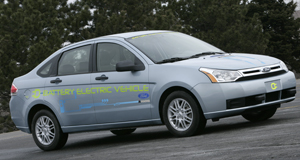
DETROIT – Magna International Inc. says its program to supply the key powertrain components for the upcoming Ford Focus electric vehicle due in 2011 marks only the beginning of the Canadian conglomerate’s move into the nascent EV market.
“Magna sees this as a growth opportunity,” J.E. “Ted” Robertson, chief technical officer and executive vice president-new product creation, says here on the sidelines of the Center for Automotive Research’s “The Business of Plugging In” conference on EV development and infrastructure.
“This is personally driven by (Magna founder and CEO) Frank Stronach,” he says of Magna’s emerging EV powertrain business. “He has a passion around this (technology).”
Robertson declines to elaborate but indicates Magna already has or is close to landing additional programs from other auto makers, saying interest in its EV technology is coming from every part of the world.
“We designed the system so that it can be adapted to other vehicles,” Robertson says, adding Ford holds no exclusivity rights on the Magna technology.
“Ford welcomes other applications,” he says “They want to be first of course, and they will be. But they want to improve the economies of scale. So if there is an opportunity to use the technology somewhere else, so be it.”
Robertson’s comments echo those of Barb Samardzich, global powertrain engineering chief for Ford, who told Ward’s earlier the auto maker was encouraging Magna to cultivate other customers, possibly including General Motors Co.’s Adam Opel GmbH operations, should Magna close a deal to acquire a controlling stake in the German company.
Ford is anticipating sales of 5,000-10,000 of Focus EVs, so for the technology to “really take off and become affordable, there is going to have to be some consolidation and economies of scale,” Samardzich said in an interview last month.

Magna began looking into EV technology two and a half years ago, Robertson says, after Stronach became concerned about the geopolitics surrounding oil and clean air.
It’s been a tough road developing the EV system, Robertson tells conference attendees, because the supplier discovered many of the components it thought it could pluck off the shelf or obtain from other parts makers weren’t suitable.
“We had to design everything from scratch,” he says.
Magna worked with Ford to co-develop the Focus’ electric drivetrain. In addition to providing the software and programming, Magna is supplying the powertrain module, gearbox, electronics and some chassis components, as well as performing key design-integration work.
Robertson says Magna already is beginning to turn attention to developing next-generation EV components and systems that will be smaller, lighter and more efficient. He expects a second-generation electric powertrain to be available in about three years.
Magna has not set a cost target for the EV technology’s next wave, he says.
Robertson has praise for the engineering work the former General Motors Corp. did on its EV1 electric car on the market in the 1990s, saying much of what the auto maker developed then still works today, including some experimental fast-charging technology.
“The EV1 was a marvelous piece of engineering work,” Robertson says. “They solved so many problems that we’re all faced with today, you can look to the EV1 and find the solution.”
Using similar fast-charging technology, Robertson says Magna’s EV battery can be fully replenished in 20 minutes, compared with 4-6 hours using a 220-volt line and 10-12 hours using a 110-volt feed.


